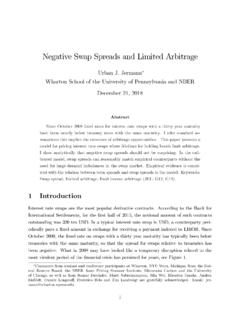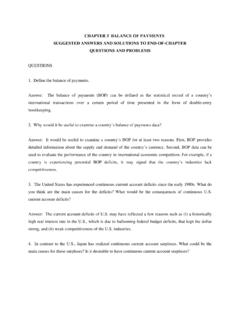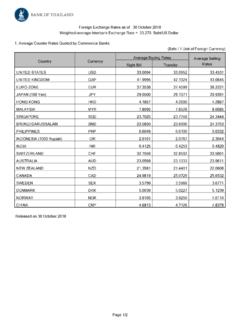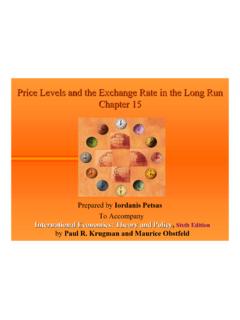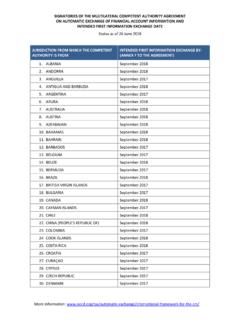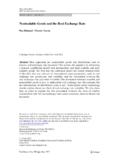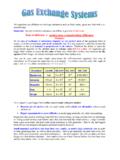Transcription of Techniques for Managing Exchange Rate Exposure …
1 Techniques for Managing Economic Exposure p. 1 Classnote Prof. Gordon Bodnar Techniques for Managing Exchange Rate Exposure A firm's economic Exposure to the Exchange rate is the impact on net cash flow effects of a change in the Exchange rate. It consists of the combination of transaction Exposure and operating Exposure . Having determined whether the firm should hedge its Exposure , this note will discuss the various things that a firm can do to reduce its economic Exposure . Our discussion will consider two different approaches to handling these exposures: real operating hedges and financial hedges. Transaction Exposure Financial Techniques of Managing Transaction Exposure Transaction Exposure hedging should have been discussed in some detail in the previous international finance course; however, we will briefly go over the standard financial methods available for hedging this Exposure .
2 The main distinction between transaction Exposure and operating Exposure is the ease with which one can identify the size of a transaction Exposure . This, combined with the fact that it has a well-defined time interval associated with it makes it extremely suitable for hedging with financial instruments. Among the more standard methods for hedging transaction Exposure are: i) Forward Contracts - When a firm has an agreement to pay (receive) a fixed amount of foreign currency at some date in the future, in most currencies it can obtain a contract today that specifies a price at which it can buy (sell) the foreign currency at the specified date in the future. This essentially converts the uncertain future home currency value of this liability (asset) into a certain home currency value to be received on the specified date, independent of the change in the Exchange rate over the remaining life of the contract.
3 Ii) Futures Contracts - These are equivalent to forward contracts in function, although they differ in several important features. Futures contracts are Exchange traded and therefore have standardized and limited contract sizes, maturity dates, initial collateral, and several other features. Given that futures contracts are available in only certain sizes, maturities and currencies, it is generally not possible to get an exactly offsetting position to totally eliminate the Exposure . The futures contracts, unlike forward contracts, are traded on an Exchange and have a liquid secondary market that make them easier to unwind or close out in case the contract timing does not match the Exposure timing. In addition, the Exchange requires position taker to post s bond (margins) based upon the value of their positions.
4 This virtually eliminates the credit risk involved in trading in futures. iii) Money Market Hedge - Also known as a synthetic forward contract, this method utilizes the fact from covered interest parity, that the forward price must be exactly equal to the current spot Exchange rate times the ratio of the two currencies' riskless returns. It can also be thought of as a form of financing for the foreign currency transaction. A firm that has an agreement to pay foreign currency at a specified date in the future can determine the present value of the foreign currency obligation at the foreign currency lending rate and convert the appropriate amount of home currency given the current spot Exchange rate. This converts the obligation into a home currency payable and eliminates all Exchange risk.
5 Similarly a firm that has an agreement to receive foreign currency at a specified date in the future can determine the present value of the foreign currency receipt at the foreign currency borrowing rate and borrow this amount of foreign currency and convert it into home currency at the current spot Exchange rate. Since as a pure hedging need, this transaction replicates a forward, except with an additional transaction, it will usually be dominated by a forward (or futures) for such purposes; however, if the firm needs to hedge and also needs some short term debt financing, wants to pay off some previously higher rate borrowing early, or has the home currency cash sitting around, this route may be more attractive that a forward contract. iv) Options - Foreign currency options are contracts that have an up front fee, and give the owner the right, but not the obligation to trade domestic currency for foreign currency (or vice versa) in a specified quantity at a specified price over a specified time period.
6 There are many different variations on options: puts and calls, Techniques for Managing Economic Exposure p. 2 European style, American style, and future-style etc. The key difference between an option and the three hedging Techniques above is that an option has a nonlinear payoff profile. They allow the removal of downside risk without cutting off the benefit form upside risk. There are different kinds of options depending on the exercise time the determination of the payoff price or the possibility of a payoff. While many different varieties exist, there are a few that corporations have found useful for the purposes of hedging transaction exposures.
7 One of these is the average rate (or Asian or Look back) option. This option has as its payoff price, not the spot price but the average spot price over the life of the contract. Thus these options can be useful to a firm that has a steady stream on inflows or outflows in a particular currency over time. One large average rate option will basically act as a hedge for the entire stream of transaction. Moreover, the firms will lock in an average Exchange rate over the period no worse than that of the strike price of this option. Finally, because the average rate is less volatile than the end of period rate (remember the average smoothes volatility this option will be cheaper than equivalent standard options. Thus the firms obtains in a single instrument hedging for a stream of transaction so reduces transaction costs plus benefits from the hedging over time of the averaging effect.)
8 Another popular exotic option for corporations is the basket rate option. Rather than buy options on a bunch of currencies individually, the firms can buy an option based upon some weighted average of currencies that match its transaction pattern. Here again since currencies are not perfectly correlated the average Exchange rate will be less volatile and this option will therefore be less expensive. There firm can take advantage of its own natural diversification of currency risk and hedge only the remaining risk. Choosing between Instruments In choosing between these different financial Techniques the firm should consider the costs and the ultimate home currency cash flows (appropriately adjusted for time value) of each method based upon the prices available to the firm.
9 The different Techniques involve different types of cash flows at different points in time and this must also be taken into account by the firm. In efficient markets, under the assumption if risk neutrality, all of these contracts should be priced so that their expected net present value is zero. In other words, contracts, such as forward and futures, that have no up front payment will have a zero expected payoff; while options, depending on their strike price and maturity, will have an expected payoff whose discounted value is equal to the up front premium. There is another important distinction between the first three Techniques and options for hedging exposures that the firm should consider in making its choice of hedging Techniques . All of these Techniques provide variance reduction to the ultimate payoff on a foreign currency denominated contract.
10 In the case of the forward contract and the money market hedge, the variance of the final cash flows is eliminated entirely. For most futures contracts and options, volatility still exists, but it has been substantially reduced. Options on the other hand also provide insurance to their purchaser. They provide a guarantee against losses above some preset amount, but do not lock the transaction into a fixed price, in case the price may turn out later to be wrong. Thus, one aspect of the decision of which financial instrument to use to hedge a known foreign currency transaction is whether one is really desiring variance reduction (say for making budgeting easier) or insurance against losses. Transaction Hedging Under Uncertainty Uncertainty about either the timing or the existence of an Exposure does not provide a valid arguments against hedging.
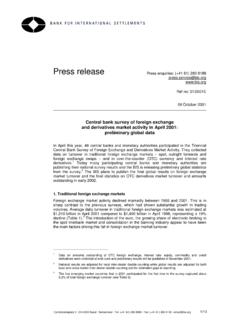
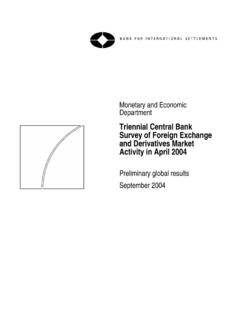


![Dif In Dif Slides.ppt [Repaired] - Wharton Finance](/cache/preview/e/2/9/5/4/6/1/8/thumb-e29546186543c246a2365bc5cbc8c9a4.jpg)
